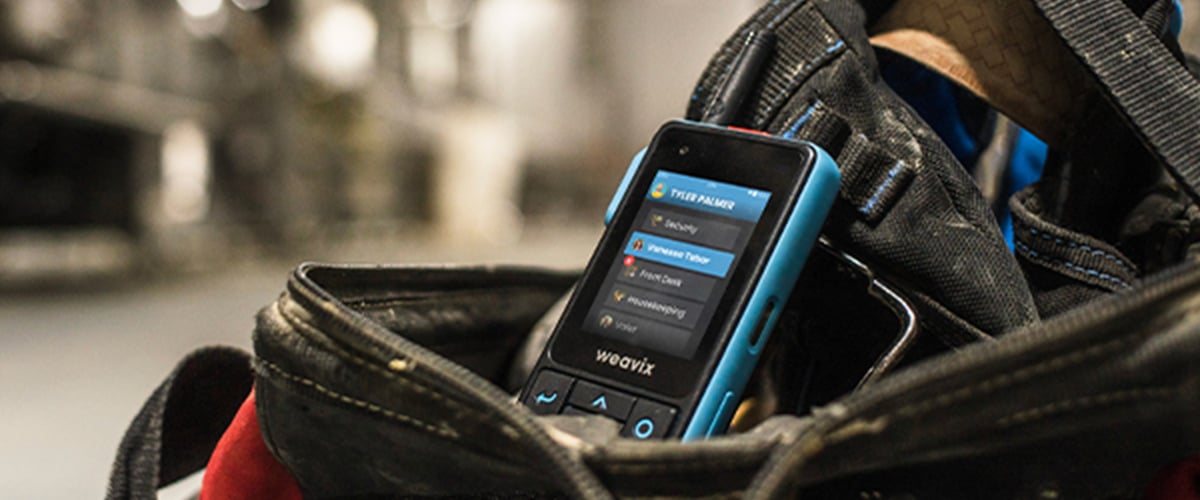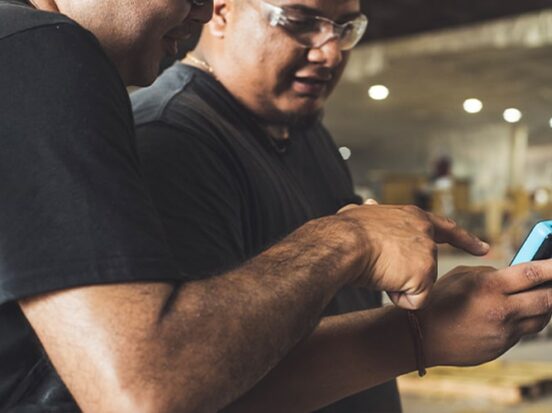Choosing the best walkie-talkies for business use can be overwhelming, especially with so many options available on the market today. To help you make an informed decision, we’ve outlined the top models, their key features, use cases, benefits, and drawbacks.
| Position | Best Walkie-Talkie for Business Use | Top Features | What Makes this Radio One of the Best Walkie-Talkies |
|---|---|---|---|
| 1 | Walt® Smart Radio System by weavix® |
| Walt stands out as the most advanced walkie-talkie for business use, offering full connectivity, dedicated channels, and safety features built for modern frontline teams |
| 2 | Motorola DP4400 |
| This radio earns its spot with audio clarity that meets basic industrial communication needs |
| 3 | Kenwood TK-3402U16P |
| Selected for durability and long battery life, though it lacks modern features found in advanced models |
| 4 | Hytera PD782 |
| Hytera secures its place with its rugged exterior, which is useful in outdoor settings, but lacks more advanced features |
| 5 | Baofeng UV-5R |
| The Baofeng UV-5R is an option for smaller teams, with a reasonable range for its price |
| 6 | Motorola MOTOTRBO R5 |
| Known for its simplicity and durability, the R5 remains a choice for teams that need basic, reliable voice communication |
| 7 | Motorola MOTOTRBO R7 |
| The R7 delivers clear audio that holds up well in loud environments |
| 8 | RelayX |
| RelayX offers push-to-talk over cellular and works across devices teams already use |
| 9 | Hytera P50 Pro |
| With LTE and built-in GPS, the P50 Pro supports teams working beyond standard radio range |
| 10 | Zello |
| Zello runs on smartphones and desktops, making it a push-to-talk option for teams without dedicated radios |
| 11 | Rapid Radios Nationwide PTT Walkie-Talkie |
| Rapid Radios offers a rugged device suitable for survivalists and preppers, but not for industrial environments |

The Importance of Industrial Walkie-Talkie System for Business Use
If your team works across different locations or in fast-paced environments, you know how critical clear communication is. Walkie-talkie systems for business use give you real-time updates, helping everyone stay aligned and respond quickly to what’s happening on the ground.
When the flow breaks down, operations slow, and you can lose people. According to L2L, poor communication is the second most common reason manufacturing workers leave their jobs, cited by 31.4% of respondents.
That’s why a basic analog radio isn’t enough. You need the best walkie-talkie — one built to handle the demands of your environment, whether running a large manufacturing facility, coordinating a construction crew, or managing a hospitality team.
Keep reading: Discover key aspects to look for in a digital communication platform
11 Best Walkie-Talkies on the Market
When looking for the best walkie-talkies for business use, there are quite a few models to consider. But none match the full range of features and reliability of the Walt Smart Radio System.
To prove it, here’s a breakdown of the best walkie-talkies and how Walt compares:
1. Walt Smart Radio System by weavix
The Walt® Smart Radio System by weavix® is the leader in frontline communication, with the latest technology and a global range advantage over all other two-way radio systems. What makes it the best walkie-talkie on this list is its ability to turn every message into a clear, timestamped record, so your teams stay accountable, safe, and aligned without guesswork.
Walt goes beyond talk: it helps orchestrate your entire operation across departments, roles, and locations. No need for physical towers, licenses, or IT setup. Walt is a nationwide walkie-talkie that connects your entire workforce instantly, whenever and wherever it matters most.
>>See how the Walt smart radio system works.
| Walt Smart Radio System by weavix | |
| Top Features |
|
| Best Use Cases |
|
| Advantages |
|
2. Motorola DP4400
This portable DMR radio delivers voice and data communications with optional integrated GPS and Bluetooth. Unlike the best walkie-talkies on the market, this device limits communication to voice and text only, so no multimedia messaging service or instant translation.
| Motorola DP4400 | |
| Features |
|
| Use Cases |
|
| Advantages |
|
| Disadvantages |
|
Keep reading: Explore the differences between weavix and Motorola legacy radio systems
3. Kenwood TK-3402U16P
This 16-channel portable two-way radio delivers professional and ergonomic performance. It’s based on a proven design — with features like scan, built-in VOX, and a long battery life. It’s one of the best walkie-talkies for reliable voice communication, but lacks features like text, image, and video messaging, as well as integration with digital communication platforms.
| Kenwood TK-3402U16P | |
| Features |
|
| Use Cases |
|
| Advantages |
|
| Disadvantages |
|
4. Hytera PD782
This series of two-way radios is relied on by customers needing a heavy-duty walkie-talkie system for businesses, designed to work in tough environments, and available in both UHF and VHF.
| Hytera PD782 | |
| Features |
|
| Use Cases |
|
| Advantages |
|
| Disadvantages |
|
5. Baofeng UV-5R
The Baofeng UV-5R is an affordable, dual-band two-way radio with 5W power, 128 programmable channels, and support for VHF and UHF frequencies.
| Baofeng UV-5R | |
| Features |
|
| Use Cases |
|
| Advantages |
|
| Disadvantages |
|
Keep reading: Understand the difference between legacy and smart radios
6. Motorola MOTOTRBO R5
The Motorola MOTOTRBO R5 is a digital two-way radio built for workers who need a simple user interface. It offers basic durability, but it lacks modern capabilities like multimedia messaging, AI transcription, and cloud-based message encryption that Walt provides.
Even though it used to be considered one of the best walkie-talkies before weavix invented smart radios, the R5 depends on additional radio infrastructure and lacks LTE or Wi-Fi support, which limits flexibility for remote or multi-site operations. The radios are expensive to replace and have many hidden fees in repairs and batteries.
| Motorola MOTOTRBO R5 | |
| Features |
|
| Use Cases |
|
| Advantages |
|
| Disadvantages |
|
7. Motorola MOTOTRBO R7
The Motorola MOTOTRBO R7 is a digital two-way radio for industrial use. While it’s one of the best walkie-talkies because of its clear audio and rugged design, the R7 lacks the advanced capabilities Walt Smart Radio by weavix provides, such as AI-powered translation and unlimited permission-based channels.
Compared to the R5, the R7 adds refinements but still depends on traditional radio infrastructure, limiting its scalability for connected workers.
| Motorola MOTOTRBO R7 | |
| Features |
|
| Use Cases |
|
| Advantages |
|
| Disadvantages |
|
8. RelayX
RelayX is a push-to-talk (PTT) communication platform that operates over cellular networks via smartphone apps. While it shares some advantages and disadvantages of walkie-talkies, it relies on smartphones and cellular connectivity, which can limit its use in harsh industrial environments.
| RelayX | |
| Features |
|
| Use Cases |
|
| Advantages |
|
| Disadvantages |
|
9. Hytera P50 Pro
The Hytera P50 Pro is a radio for industrial use with a touchscreen interface and GPS. It’s one of the best two-way radios for business use because of its extended range communication compared to traditional radios. However, it still lacks some of Walt’s robust safety solutions. Its complexity and higher price might also make it less suitable for frontline communication.
| Hytera P50 Pro | |
| Features |
|
| Use Cases |
|
| Advantages |
|
| Disadvantages |
|
10. Zello
Zello is a software-based PTT communication platform that runs on smartphones and desktop devices. It enables instant voice communication with multimedia messaging features. While it supports wide connectivity, it lacks the rugged hardware and built-in safety features expected from the best walkie-talkies for frontline industrial use.
| Zello | |
| Features |
|
| Use Cases |
|
| Advantages |
|
| Disadvantages |
|
11. Rapid Radios Nationwide PTT Walkie-Talkie
Rapid Radios Nationwide PTT Walkie-Talkie offers push-to-talk communication through cellular networks with dedicated radios. While the hardware is rugged and supports voice and text messaging, Rapid Radio reviews often highlight that the device won’t work in remote areas lacking reliable cellular coverage.
| Rapid Radios Nationwide PTT Walkie-Talkie | |
| Features |
|
| Use Cases |
|
| Advantages |
|
| Disadvantages |
|
Key Features to Look for in a Walkie-Talkie System
Today’s systems integrate advanced technologies that significantly improve coordination and productivity on the manufacturing floor or job site. The best walkie-talkies for business use now include communication solutions like multimedia messaging, dictation, and text-to-speech, which give teams the tools they need to communicate seamlessly and efficiently.
When you’re on the hunt for the best walkie-talkie system for your team, here are the key features to look for, along with how they benefit businesses across multiple sectors:
| Walkie-Talkie System Feature | Definition | Business Benefit |
|---|---|---|
| Range | The physical distance your walkie-talkie can reach | Clear communication across large areas, such as construction sites or warehouses |
| Battery Life | How long your set of walkie-talkies can operate without needing to recharge | Continuous communication for businesses with long shifts or limited access to charging |
| Durability | A radio's ability to withstand tough environments with waterproof, dustproof, and shock-resistant features | Helping walkie-talkies withstand tough environments like food and beverage manufacturing floors or offshore oil rigs |
| Noise Cancelling | A technology that reduces background noise to enhance voice clarity | Critical for industries like construction or hospitality, where noise levels are high |
| PT3 Multimedia Collaboration | A technology that enables real-time text, picture, or video messaging combined with a push-to-talk button | Teams stay connected and can collaborate effectively to improve productivity |
| AI-Powered Language Translation | Instant message translation in any language | Smoother cross-language communication, especially in a diverse workforce |
By combining these different features, options like the Walt Smart Radio System stand out in the market, offering more than just basic communication — transforming how teams work together.
Keep reading: How to choose the right smart radio
Top Business Use Cases for a Long-Range Walkie-Talkie
A long-range walkie-talkie system for business use is indispensable in industries that require seamless communication over vast areas. Whether in retail or oil and gas, having the right tools can drastically improve operations and efficiency.
| Industry | Long-Range Walkie-Talkie Use Cases |
|---|---|
| Manufacturing | Walkie-talkies keep large teams in sync across multiple factory floors (i.e., food and beverage or automotive) and 3PL warehouses |
| Construction | Communication between supervisors and workers across a large construction site |
| Food & Beverage | Keeping large teams connected across a large manufacturing floor |
| Oil & Gas | Connecting a large team in a harsh environment across multiple locations |
| Hospitality | Coordinate large groups of employees between multiple floors and buildings |
| Aviation | Assist in Refueling efforts, such as at PrimeFlight |
The best long-range walkie-talkie system for business lets workers maintain clear and uninterrupted communication, no matter the worksite size or the operation’s complexity. These models vary in terms of features, functionality, and technology, offering options such as analog, digital, and smart industrial radios, each suited to different communication needs and environments.
Keep reading: Everything you need to know about digital vs analog radio system
How do you choose the best walkie-talkie?
Choosing the best walkie-talkie starts by understanding the real challenges your team faces on the ground. In industrial environments, communication gaps can slow operations, cause safety hazards, and increase downtime. To avoid these, keep these best practices in mind:
- Prioritize durability. Your radios must survive drops, dust, moisture, and temperature swings. If devices break or malfunction regularly, you’ll face costly repairs and communication blackouts.
- Look for clear audio designed for noisy spaces. If your team can’t hear messages over machinery or background noise, instructions get missed, leading to errors or safety incidents.
- Check battery life carefully. Long shifts demand radios that last through a full day without frequent recharges. A dead radio means delayed responses and stalled workflows.
- Choose a walkie-talkie with extended range or multi-network capability. Large sites and multiple buildings require devices that maintain connection without dead zones. Losing signal puts workers out of the loop and increases risk.
- Consider safety features like emergency alerts and location tracking. Quick response can save lives. Without these, emergencies may go unnoticed or take longer to manage.
Skipping any of these factors risks higher injury rates and lost productivity. The best walkie-talkie fits your site’s specific environment and workforce needs. Don’t settle for one-size-fits-all.
Go with the Smart Walkie-Talkie Choice with walt
When choosing the best walkie-talkie on the market, the Walt Smart Radio System is the top contender, combining smart features, long-range capabilities, and rugged durability to meet and exceed any business’s requirements. Unlike its competitors, Walt offers future-proof features like AI-powered language translation, multimedia messaging, and seamless integration with the weavix platform, all with an easy communication platform implementation.
In a market full of great and not-so-great options, Walt stands out by offering incredibly smart, simple features that aren’t available with other walkie-talkies. For businesses looking to take communication to the next level with one of the best walkie-talkies, Walt is the clear choice.
To learn how the walt can take your team’s communication and safety into the future, book a demo today and see how a smart radio can elevate your business.
Frequently Asked Questions
What common challenges can you face with walkie-talkies for business?
Walkie-talkies for business use often run into issues like limited range and poor audio clarity, not to mention durability that underperforms in demanding environments. In industrial settings, these problems slow down operations and even create safety risks.
- Radios that drop out or suffer interference risk urgent instructions not getting through, leading to errors or accidents
- Devices that don’t last a full shift cause frequent replacements or downtime, impacting the frontline employee experience
- Many traditional radios lack easy integration with digital systems, making it harder to track team movements or escalate alerts quickly
The best walkie-talkies help you overcome these challenges with reliable sound and robust capability that work smoothly with operational tools.
Keep reading: Compare Walt vs smartphones vs two-way radios to understand their differences
What are the best walkie-talkies to buy?
The best walkie-talkies to buy depend on your specific needs, but for tough, industrial settings, focus on radios that combine durability, clear audio, and reliable range. Look for devices with:
- Waterproof and dustproof ratings to handle harsh conditions
- Long battery life to avoid interruptions in critical tasks
- Multiple channels and easy group management to help teams stay organized, especially across large sites
With Walt, you get more than just a durable radio. You gain a smart communication system that helps you eliminate workforce communication barriers across multiple sites and roles, without extra infrastructure or complicated setup.
What is the best walkie-talkie for industrial use?
For industrial use, the best walkie-talkie balances ruggedness with smart capabilities. It should:
- Deliver clear audio, since background noise is common and misheard messages can lead to mistakes
- Withstand drops, moisture, and dust to survive tough conditions on the floor
- Offer an extended range so workers across different areas or buildings stay connected without signal loss
- Include a workforce danger alert system to quickly notify teams of emergencies and improve safety
What makes Walt the best walkie-talkie for long-range communication?
Walt stands out as the best walkie-talkie for long-range communication because it connects over both Wi-Fi and LTE, giving it true global range far beyond traditional radio limits. Whether your teams spread across multiple buildings and sites, they stay instantly reachable without signal dropouts.
Walt’s also a device for language translation, removing communication barriers in diverse workforces, and helping every worker understand each other clearly. Plus, its safety solutions like man-down alerts and location tracking ensure quick responses in emergencies. For companies managing large, dispersed teams, Walt turns communication into a strategic advantage.


